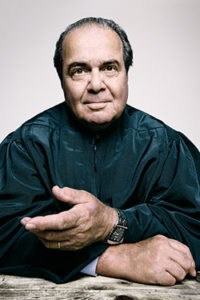Textualism and the Courts (A Wee Bit Wonky)*

Justice Antonin Scalia, Textualist
The Book
I finished The Justice of Contradictions: Antonin Scalia and the Politics of Disruption by Richard Hasen recently. Dealing with complex matters, Mr. Hasen offers lucid analysis and a fine read!
Straightaway, Mr. Hasen tells readers he has not written a Scalia biography, or a “comprehensive examination of all of [Justice] Scalia’s opinions and ideas.” Instead, he promises “an examination of [Justice Scalia’s] jurisprudential theories of textualism and originalism, his inimitable and caustic tone in dealing with his adversaries on and off the Court, and his key areas of modern American law.” And he delivers, in plain English!
I’m focused here on textualism, the legal principle which holds that judges must ascertain the objective meaning of statutory and constitutional provisions. For textualists, legislative history matters not at all. Intent and context (mostly) get ignored. Fairness? Fie on thee!
On the subject of textualism Mr. Hasen’s first example involves Rule 609 of the Federal Rules of Evidence, in effect in 1984 and considered in Green v. Bock Laundry Machine Company, No. 87-1816. Paul Green, a convict on a work furlough, lost his arm in a laundry machine. He sued for damages. Relying on Rule 609, the trial judge let the jury hear about Mr. Green’s felony. Not surprisingly, the jury ruled against Mr. Green. (Felons do poorly in court, even when their crimes have nothing to do with the litigation.)
Justice John Paul Stevens—who, by the way, celebrated his 98th birthday this past Friday—wrote the majority opinion. Justice Scalia concurred. Both men acknowledged the absurd outcome, and both paid attention to legislative history. And they got to the absurd outcome by supporting the application of the rule in a situation the rule never contemplated. (Congress fixed Rule 609 after the Green decision.)
The Case
Mr. Hasen’s book showed up front and center in my mind earlier this week when I heard about Pereira v. Sessions, No. 17-459, on NPR. The case involves a Notice to Appear in an immigration case. In 8 U.S.C. § 1229 (Initiation of removal proceedings) Congress sets forth a procedure for removing aliens. (The word in the statute, and not the one I’d choose.) The case turns on compliance with the procedure.
Wescley Perreira got a Notice to Appear within the 10-year period, but it was silent about the where and the when associated with appearing. Silent, even though subsection G references specifying“[t]he time and place at which the proceedings will be held.” (Think: date and court address on a speeding ticket.) And, so, a battle to the nth gets joined!
Here’s the transcript of the oral argument before the U.S. Supreme Court on Monday, April 23. Best question? From Justice Sonia Sotomayor (directing her question to the attorney for the United States):
Mr. Liu, help me. I — I — I’m simple-minded. Notice to Appear seems to ask me when, where, and why. Those are the three material elements of, to my simplistic way of thinking, of the words Notice to Appear: When am I appearing, and for what? That — that — those seem the two most critical components of that word — of those words.
When I heard the NPR story I wondered how this case ever got to the Supreme Court, for a Notice to Appear has to say where and when. Duh, right? Nope. The transcript provides lots of “definitional language” arguments, a smattering of Chevron deference, and some other rules judges use to determine intent. I think the government loses, but the transcript left me wondering.
Closing Thoughts
Interpretative rules give Congress lots of deference. Being extremely generous here, we elect talented and capable people to represent us. Sometimes. We assume they write, read, understand, and consider the language in the laws they vote on. Not, almost always. We assume, as well, that the bills they have passed include language susceptible to only one reasonable interpretation. Rarely. Then, textualism—the only method for dealing with legislative interpretation which ever really passed muster with Justice Scalia—will provide the only ascertainable outcome which reflects Congressional intent. Right. Sure. Argle-bargle.
Textualism depends for its validity on the notion that Congress means what it says, completely! I appreciate the theoretical concern about unelected judges and justices making decisions. Read Mr. Hasen’s book to appreciate more fully Justice Scalia’s willingness to pick and choose, using textualism and originalism, or not, to get to desired outcomes.) All of the alleged principles aside, however, a jurisprudential model which assumes Congress intends the plain meaning of its words—assuming a plain meaning might be apparent—amounts to so much poppycock! Or argle-bargle.
*Paul Krugman writes regular, easy to read columns for the New York Times. And, sometimes, he generates Black Holes, so dense as to be incomprehensible without a degree in economics. They get “degrees of wonk” labeling. Like Steel Tariffs and Wages (Painfully Wonkish).
